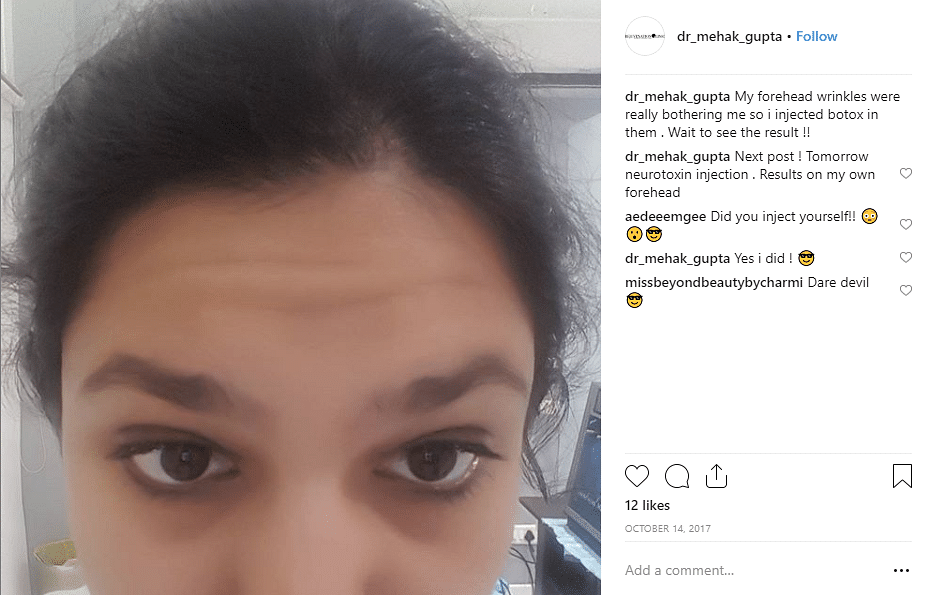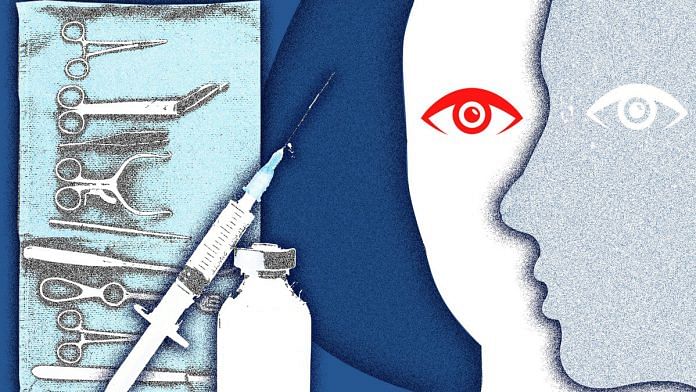The popularity of cosmetic surgery is seeing younger people opt for Botox, which lessens the appearance of fine lines.
New Delhi: When Dr Mehak Gupta, a cosmetic surgeon based in Chandigarh, noticed some wrinkles in her forehead, she knew what she had to do. She injected Botox shots into her forehead.
Only, Gupta is not a middle-aged woman trying to navigate her journey from youth to the feared “sunset years”. She is 28.
The reason, she told ThePrint, was simple.
“Everyone wants to look good,” Gupta said. “And rather than waiting for your 30s or 40s to restore the skin with Botox, people are now a lot more open to getting injections in their 20s to consistently preserve a youthful look.”

In a world increasingly obsessed with looking young, Gupta is not the only one who has stopped buying the promise of anti-ageing creams, which claim to beat without surgery the “fine lines” the cosmetics industry has taught the world to fear.
Botox, or Botulinum toxin, is a neurotoxin protein (it can reportedly prove lethal in high doses) that can paralyse muscles and lessen the appearance of wrinkles and crow’s feet, thus lending the patient a younger look. Effects can last up to four months, and Botox can even slow the formation of new lines.
One unit of Botox costs approximately Rs 500. To get the entire upper face area treated requires close to 20 units, making the cost of one sitting Rs 10,000.
Several Hollywood celebrities have reportedly taken Botox or other fillers, but the procedure was almost always known to be the preserve of the middle-aged.
Not anymore, it seems.
“People in their 20s are extremely conscious of their appearance. At least 30 of my clients are below 30 years of age and looking to get Botox injections to remove special lines or smoothen out their pores,” Dr Gupta told ThePrint.
“The old come for correction, while the young are interested in enhancement,” Dr Charanjeet Sobti, a Delhi-based plastic surgeon, told ThePrint.
“Even people with early signs of wrinkling, 35 or younger are getting Botox,” Sobti said, adding that “earlier the average age was 45-50”.
Dr P.K. Tomar, a plastic surgeon from Delhi, said he had noticed a similar trend among men vis-à-vis hair transplants, a procedure earlier associated with 40-60-year-olds.
“Some opt for intervention as early as 23-24 years of age when the signs start showing,” he added.
Face-off
Meanwhile, the popularity of procedures that enhance one’s overall appearance continues to grow. China and India together have reportedly made Asia the largest market for cosmetic surgery.
Talking to ThePrint, Dr Reema Arora, a specialist in non-invasive cosmetic makeovers at Delhi’s Cocoona Centre of Aesthetic Transformation, said makeovers around the eyes, lips and eyebrows were the latest fad among youngsters.
She recalls an aspiring model in her 20s, now a celebrity, who came to her to “change her features” because she considered her square face and dark skin tone impediments to her showbiz dreams.
“We created non-surgical cheeks, we gave her a very sharp nose and she’s also three or four tones lighter now than her actual colour,” she said. “You can’t even recognise if she’s the same girl.”
Also read: These apps can reveal your make-up’s dirty secrets
Freezing the fat
Another popular procedure is “fat-freezing” or “coolsculpting”, as Cryolipolysis is colloquially known, which involves killing fat cells underneath the surface of the skin by freezing them to sub-zero temperatures.
At Nidsun, “the one-stop destination for health, fitness & looking good”, in Delhi’s Saket, the demand for fat-freezing is through the roof, say staff.
“We’ve seen at least 30 clients in the past two months alone, and we’ve been open since 2013,” Nidsun manager Anjana Kaur told ThePrint.
According to Nidsun, roughly 60 per cent of their “hundreds of clients” over the years, were below the age of 40.
One session of fat-freezing costs at least Rs 16,000. Within a span of 30 to 90 days, Kaur said, patients notice 2-3 inches of fat loss from the targeted area.
The cosmetic surgery craze has found quite a few takers among men as well in recent years, with a procedure that promises to carve out abs getting ever more popular.
Dr Chetan Satish, a plastic surgeon based out of Delhi, told ThePrint that 40 per cent of his patients were men, while Dr Tomar says that at least 25 per cent of his clients are now men, “which was only 5 per cent a few years ago”.
Talking about the six-pack procedure, Dr Satish explained that it involves “doing a superficial liposuction through small holes wherein we suck the fat in such a way that the creases for the packs, be it for getting six- or eight-pack abs, are created”.
The hidden costs
However, sometimes the pursuit of perfection comes at a cost — both psychological and physical.
Clinical psychologist Roshni Bhagnani told ThePrint that the satisfaction a person may receive by altering their physical appearance is “temporary”.
“I call it temporary because beauty standards are dynamic, and very soon the patient might want to indulge in a cycle of cosmetic procedures to further alter and correct their features,” she added.
According to her, cosmetic surgery can also have huge emotional and psychological consequences, sometimes leading patients to isolation, anger and adjustment difficulties.
“A consultation with a psychologist should be made mandatory before the procedure,” Dr Bhagnani said. “It’s important to identify the patient’s motivation and expectation from the surgery and their purpose to do so.”
Dr Meghna Gupta, a specialist in dermatology and non-invasive cosmetic makeovers at Delhi Skin Centre, told ThePrint that health hazards mainly arose when the medical professionals approached were not qualified enough.
“A lot of professionals who pose as healthcare providers are not qualified enough. A word of caution to any patient/client or a customer is that one should do their homework by approaching only a well-trained professional who will always correctly guide you.”
Also read: How long can Rajinikanth stop time with 2.0 special effects?



